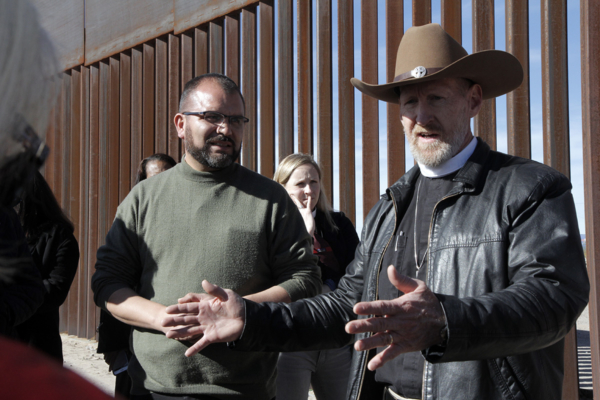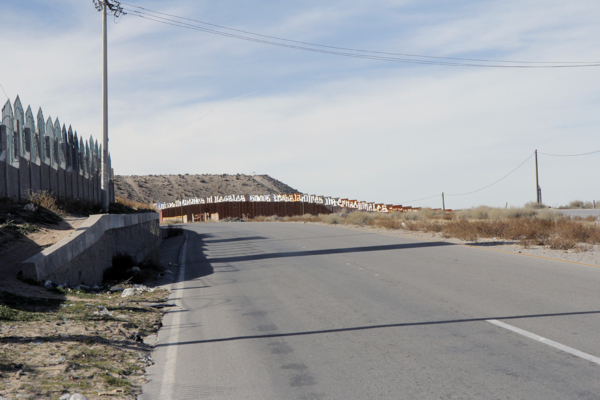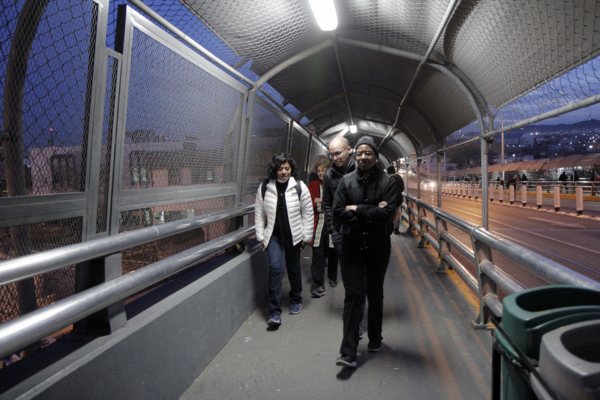El Paso pilgrimage shines a ‘light of truth’ on migrant humanitarian crisis at the borderPosted Dec 17, 2018 |
|

The Rev. Paul Moore, right, who chairs the Rio Grande Diocese’s Borderland Ministries, interprets for the Rev. Hector Trejo, left, who serves three Anglican churches in Ciudad Juárez, Mexico, which is across the border from El Paso, Texas. Photo: Lynette Wilson/Episcopal News Service
[Episcopal News Service – El Paso, Texas] Two thousand people are released weekly by U.S. Immigration and Customs Enforcement into the hospitality of Annunciation House here in El Paso.
Many of them are families who have waited their turn to cross the border and request asylum. If Annunciation House had space for 2,500, it would be 2,500, said its founder and director, Ruben Garcia.
The asylees receive food, a bed, toiletries, a care package, access to a shower and help contacting relatives to arrange travel. Within 48 hours, they are placed on buses or airplanes to reunite with family members in other parts of the United States.
“The vast majority of people have someone,” Garcia said.
Mostly, they come from El Salvador, Guatemala and Honduras, but some come from Nicaragua, Brazil, Cuba, Venezuela, even as far as India. Some are fleeing violence, some come for economic opportunities, others are escaping religious and other forms of persecution.

Some 30 people representing large urban and suburban Episcopal congregations gathered in Southwest Texas for what they called an “El Paso Pilgrimage.” Here they gather on the Ciudad Juárez side of the border wall separating Mexico and the United States. Photo: Lynette Wilson/Episcopal News Service
On Dec. 13, some 30 people representing large urban and suburban Episcopal congregations gathered in Southwest Texas for what they called an “El Paso Pilgrimage.” The Rev. Gary Jones, rector of St. Stephen’s Church in Richmond, Virginia, initiated the pilgrimage out of a desire to counter a narrative that vilifies asylum seekers as drug dealers and rapists, when in fact they are fleeing for their lives and their livelihoods.
The pilgrimage’s first stop was Annunciation House, where participants heard a briefing from Garcia, who has worked on the border for 40 years, witnessing and responding to various migrant and refugee surges over the years.
“The phenomenon of refugees is not an El Paso problem, it’s a U.S. problem,” said Garcia.
“Right now, because of [U.S.] enforcement, we are seeing changes that make life miserable,” he said. “The border has become a very complicated place.”
When Annunciation House began its ministry 40 years ago, it was primarily serving men who would come to the United States for seasonal work, return home to be with families and later return for work. In 1996, when the last legislative change in immigration law made it impossible to come and go, the men could no longer go home and instead stayed.
“Once they make the decision to stay, they lose family,” Garcia said.

Writing along the border fence outside San José Anglican Church on the Mexico side of the border reads, “We are not delinquents or illegals, we are international workers.” Photo: Lynette Wilson/Episcopal News Service
With the mid-1990s change in immigration law, the undocumented population rose from 6 million to 12 million by 2004, as men sought family reunification and women and children began arriving. Today, there are 11 million undocumented immigrants in the United States; some have been living in hiding for 20 to 30 years, he said.
Upon arrival, migrants and asylum seekers are faced with either pleading their cases to agents at designated points of entry or climbing over walls and crossing rivers to plead their case upon apprehension by agents of U.S. Customs and Border Protection, or CBP, Garcia explained.
A couple of weeks ago, asylum seekers were sleeping on the bridge so as not to lose their place in line, as typically 20 people are allowed to enter at a time. Then, in an effort to clear the bridge, CBP began issuing numbers, written in magic marker on asylum seekers’ arms to keep track of their place in line, he said.
From there, they are sent to shelters in Ciudad Juárez, just across the border, to wait their turn.

Miguel Escobar, executive director of Episcopal Divinity School at Union Theological Seminary, greets children from the Rancho Anapra municipality outside the center of Ciudad Juárez. Photo: Lynette Wilson/Episcopal News Service
The Episcopal pilgrims arrived in El Paso just as news broke of the death of a 7-year-old Guatemalan girl in U.S. Border Patrol custody a day after she, her father and 161 other migrants surrendered to agents after crossing illegally into New Mexico. The circumstances of the girl’s death are still under investigation.
For the pilgrims, though, it was a stark reminder of the perilous journey migrants and asylum seekers face, as well as the outdated U.S. immigration system and the Trump administration’s response to the current humanitarian crisis on the Southwestern border. The government has sent at least 8,000 troops to the border in an attempt to deter crossings. Still, migrants continue to arrive in caravans.
“I wanted to see with my own eyes what’s going on,” said the Ven. Juan Sandoval, an archdeacon in the Diocese of Atlanta and a third-generation Mexican-American who grew up in Phoenix.
“It just seemed instead of the military, you should be sending churches and aid workers, people who can help,” he said.

The Very Rev. Nathan LeRud, dean of Trinity Episcopal Cathedral in Portland, Oregon, stands on the Ciudad Juárez side of the wall separating Mexico and the United States at the border in El Paso, Texas. Photo: Lynette Wilson/Episcopal News Service
That’s where the churches come in. Mostly, hospitality comes from El Paso churches, with the Roman Catholic Church and Annunciation House leading the way. Some asylum seekers receive legal assistance from organizations like the Las Americas Immigrant Advocacy Center, the second stop on the pilgrims’ journey.
There, Christina Garcia, who provides legal consultation, explained the complexity of family reunification, which can take 20 or 30 years depending on U.S. quotas and the country of origin, and the difficulty in winning asylum cases. Her agency, she said, won six asylum cases in six years and, in a major victory, seven so far this year.
The current crisis, she said, “is dehumanizing in every aspect and ignores the humanitarian right to access.” She also said El Paso, Atlanta, and the state of Arizona are the most difficult places to gain asylum, and in El Paso, as in the rest of the United States, judges make arbitrary determinations case by case.
From there, the pilgrims went to St. Christopher’s Church, one of five El Paso Episcopal churches and the one closest to the border, led by the Rev. J.J. Bernal. The Rev. Paul Moore, who chairs the Rio Grande Diocese’s Borderland Ministries, gave an overview of the current situation as it relates to Central America, talking about the failure of trickle-down economics, U.S. foreign policy as it has historically related to Central America, deportation of gang members, security issues across the Northern Triangle, drug cartels, associated violence and the United States’ appetite for drugs.
Across Central America’s Northern Triangle, a region that includes El Salvador, Guatemala and Honduras, more than 700,000 people have been displaced by violence. However, forced displacement is a global phenomenon now affecting a record 68.5 million people worldwide.
The pilgrimage followed on a Border Ministries Summit organized by Moore and held here in November.
On Dec. 14, the pilgrims departed for Ciudad Juárez, some crossing by car and others using pedestrian access along two of the three bridges connecting the two cities. In Juárez, the Rev. Hector Trejo, who arrived six months ago from Chihuahua, the capital of the state of Chihuahua, took them by bus to two of his three Anglican parishes.
San José, or St. Joseph’s, is located along the border in Rancho Anapra, an impoverished settlement on the city’s northwest side, previously a cattle ranching area that squatters settled and that drug cartels have infiltrated.
“Because the people here don’t have property rights it became a place for the criminal element,” said Trejo. “There are safe houses, and it’s a movement center for drug traffickers and people smugglers.
“The challenge here is great,” he added, saying community members ask him for advice on how to get over the wall because they fear for their lives.

From right, the Very Rev. Kelly Brown Douglas, dean of the Episcopal Divinity School at Union Theological Seminary, Miguel Escobar, executive director of Episcopal Divinity School, and the Rev. Winnie Varghese, director of justice and reconciliation at Trinity Church Wall Street, cross the Paso del Norte International Bridge into El Paso, Texas. Photo: Lynette Wilson/Episcopal News Service
Unlike the Roman Catholic Church, the Anglican Diocese of Northern Mexico doesn’t have an established ministry serving migrants; it was one thing the Episcopalians were looking to get involved in and something Trejo addressed. The reality is such, he said, that volunteers need to be trained properly to deal with people who’ve been traveling for weeks and sometimes months, people who haven’t bathed or brushed their teeth in a long time, and who have fled traumatic, violent, abusive situations and encountered the same along their journey. Still, he’s looking for partners in ministry and to build a network of responders along the border.
It was something Bernal, the rector of St. Christopher’s in El Paso, echoed. The Episcopal Church, he said, needs to articulate and establish a vision for its ministry at the border.
“The Episcopal Church is a voice for the voiceless,” he said. “Those of us here at the border feel isolated. We need more active voices and human resources.”
Through its Borderland Ministries, the Rio Grande Diocese is looking to expand its ministry, said Moore.
And that, he said, must take the form of grassroots ministry led by those on the ground through partnerships based in mutual respect, not patriarchy.
On the last day of the Dec. 13-15 pilgrimage, two carloads of pilgrims departed for Tornillo, Texas, the site of a camp that opened to house 360 unaccompanied minors and now houses 2,700. They didn’t quite reach the camp, as Border Patrol agents told them it is private property, but they got as close as possible and gathered at a fence to pray for the children in custody there: for their safety, their grieved parents and their futures.
“I’m really glad we went to the camp — I won’t call it a shelter, it’s not a shelter — it’s a concentration camp for children,” said the Rev. Stephen Carlsen, dean and rector of Christ Church Cathedral in Indianapolis. “I felt I needed to witness what is being done in our names as Americans.
“I can’t imagine what it would be like if the U.S. border is your last hope … how people are [mis]treated and dehumanized,” Carlsen said. “If this is their last hope, what must they be fleeing?”
– Lynette Wilson is a reporter and managing editor of Episcopal News Service.

Social Menu